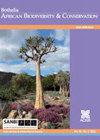Precipitation mediates termite functional diversity and dominance in southern Africa
IF 0.5
4区 生物学
Q4 PLANT SCIENCES
引用次数: 0
Abstract
Background: Termites are important ecosystem engineers in the tropics and sub-tropics, so understanding their diversity, particularly their functional diversity, across biogeographical scales is important for understanding where they alter theenvironment and deliver ecological services. Feeding groups combine phylogeneticand dietary information about termites into ecologically significant functional categories.Objectives: To characterise termite feeding group prevalence, distribution and diversity in southern Africa and assess the effect of precipitation on termite diversity and assemblage composition.Method: Termite genus and species-level occurrence data were acquired from the South African Termite Database and classified into one of five feeding groups. We evaluated the prevalence of each feeding group and assessed species and feeding group richness and dominance. Linear regressions were performed to determine the relationship between 1) species richness and precipitation; and 2) feeding group richness and precipitation.Results: We find that southern Africa 1) is dominated by FG-IIw (feeding group – II, wood feeding) termites; 2) is occupied by multiple feeding groups across the entirety of the rainfall gradient; and that precipitation 3) influences feeding group species diversity variably; and 4) causes notable shifts in termite community structure.Conclusion: Our results indicate that termites likely make substantial contributionsto plant material decomposition across southern Africa and that while shifts in feeding group dominance are associated with rainfall gradients, the services unique to individual feeding groups are not isolated to certain regions, but ratherare widespread regardless of the amount of precipitation received.降水调节南部非洲白蚁功能多样性和优势
背景:白蚁是热带和亚热带重要的生态系统工程师,因此了解它们的多样性,特别是它们的功能多样性,对于了解它们在何处改变环境和提供生态服务非常重要。摄食类群结合了白蚁的系统发育和饮食信息,形成了具有生态意义的功能类群。目的:了解非洲南部白蚁摄食群体的流行、分布和多样性,并评估降水对白蚁多样性和组合组成的影响。方法:从南非白蚁数据库中获取白蚁属和种级发生数据,并将其分为5个摄食组。我们评估了每个摄食组的患病率,并评估了物种和摄食组的丰富度和优势度。通过线性回归确定了1)物种丰富度与降水之间的关系;2)饲养群丰富度与降水量。结果:非洲南部1)以FG-IIw(取食组-II,取食木材)白蚁为主;2)在整个降雨梯度上被多个觅食群所占据;降水对摄食群物种多样性的影响是不同的;4)引起白蚁群落结构的显著变化。结论:我们的研究结果表明,白蚁可能对整个非洲南部的植物物质分解做出了重大贡献,尽管摄食群体优势的变化与降雨梯度有关,但个体摄食群体所特有的服务并不局限于某些地区,而是与降雨量无关的广泛存在。
本文章由计算机程序翻译,如有差异,请以英文原文为准。
求助全文
约1分钟内获得全文
求助全文
来源期刊

Bothalia
生物-植物科学
CiteScore
1.70
自引率
0.00%
发文量
12
期刊介绍:
Bothalia: African Biodiversity & Conservation is published by AOSIS for the South African National Biodiversity Institute (SANBI) and aims to disseminate knowledge, information and innovative approaches that promote and enhance the wise use and management of biodiversity in order to sustain the systems and species that support and benefit the people of Africa.
The journal was previously published as Bothalia, and had served the South African botanical community since 1921. However the expanded mandate of SANBI necessitated a broader scope for the journal, and in 2014, the subtitle, African Biodiversity & Conservation was added to reflect this change.
 求助内容:
求助内容: 应助结果提醒方式:
应助结果提醒方式:


